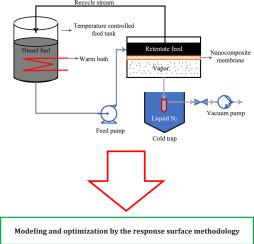Chemical Engineering and Processing: Process Intensification ( IF 3.8 ) Pub Date : 2021-03-22 , DOI: 10.1016/j.cep.2021.108396 S.H. Esmaeili-Faraj , A. Hassanzadeh , F. Shakeriankhoo , S. Hosseini , B. Vaferi

|
Sulfur compounds in diesel fuels result in environmental pollution and corrosion in automobile engines. Therefore, it is crucial to reduce the sulfur content as much as possible. This study focuses on the fabrication of nanocomposite membranes from the polypropylene-polyethylene blend and alumina nanoparticles for application in the pervaporation process to separate sulfur compounds from diesel fuels. The effect of temperature, nano-alumina, and polyethylene dosage of the membrane on the permeation flux and enrichment factor of sulfur compounds investigates from experimental and modeling perspectives. Experimental results showed that the permeation flux increases by temperature and alumina concentration and decreases by the membrane polyethylene dosage. The temperature increases the enrichment factor for membranes with low alumina content and decreases the enrichment factor for the membranes with high alumina content. The polyethylene dosage of the membrane increases the enrichment factor at a low temperature and decreases the enrichment factor at a high temperature. Finally, the response surface methodology justified that a nanocomposite membrane (0.475 wt% of alumina nanoparticles, 5.09 wt% of polyethylene polymer) at a temperature of 40°C removes the maximum amount of sulfur compounds. In this optimum condition, the permeation flux is 3.82 kg/m2 h, and the enrichment factor is 1.71.
中文翻译:

氧化铝/聚合物纳米复合膜对柴油燃料的脱硫:响应面法的实验分析与建模
柴油中的硫化合物会导致环境污染和汽车发动机腐蚀。因此,至关重要的是尽可能降低硫含量。这项研究的重点是由聚丙烯-聚乙烯共混物和氧化铝纳米颗粒制造纳米复合膜,用于渗透蒸发过程中,以从柴油中分离出硫化合物。从实验和模型的角度研究了膜的温度,纳米氧化铝和聚乙烯用量对硫化合物的渗透通量和富集因子的影响。实验结果表明,渗透通量随着温度和氧化铝浓度的增加而增加,而随着膜聚乙烯剂量的增加而减小。温度增加了具有低氧化铝含量的膜的富集因子,并降低了具有高氧化铝含量的膜的富集因子。膜的聚乙烯剂量在低温下增加了富集因子,而在高温下降低了富集因子。最后,响应表面方法证明了在40°C的温度下使用纳米复合膜(0.475重量%的氧化铝纳米颗粒,5.09重量%的聚乙烯聚合物)可以去除最大量的硫化合物。在此最佳条件下,渗透通量为3.82 kg / m 响应表面方法证明了在40°C的温度下使用纳米复合膜(0.475重量%的氧化铝纳米颗粒,5.09重量%的聚乙烯聚合物)可以去除最大量的硫化合物。在此最佳条件下,渗透通量为3.82 kg / m 响应表面方法证明了在40°C的温度下使用纳米复合膜(0.475重量%的氧化铝纳米颗粒,5.09重量%的聚乙烯聚合物)可以去除最大量的硫化合物。在此最佳条件下,渗透通量为3.82 kg / m2 h,富集因子为1.71。











































 京公网安备 11010802027423号
京公网安备 11010802027423号